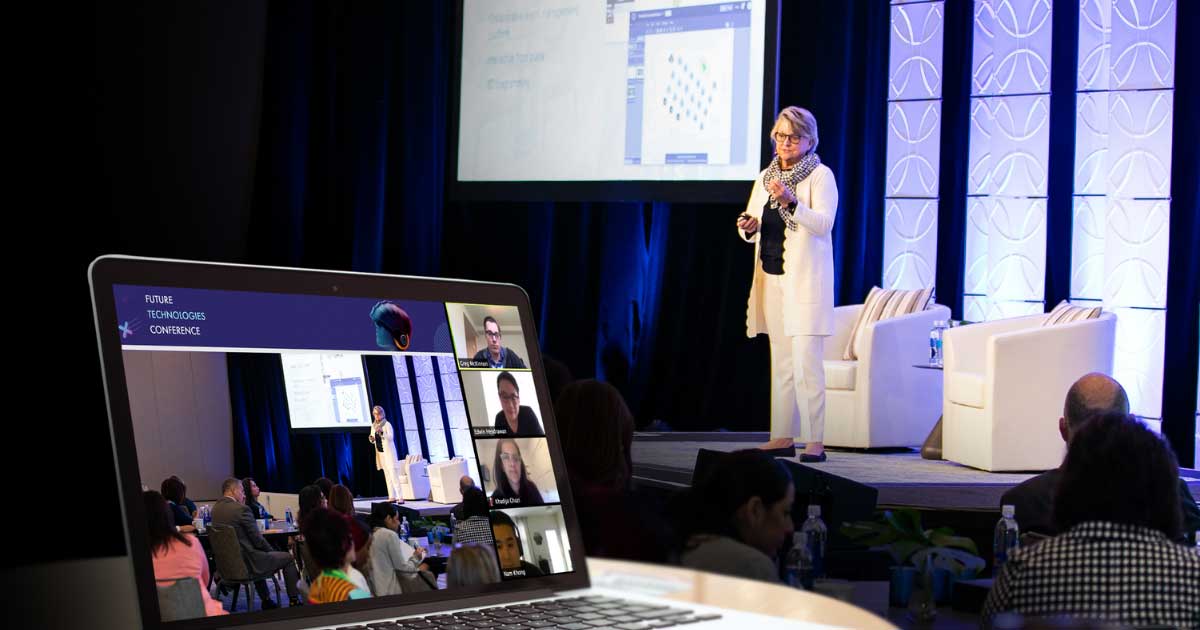We know how important face-to-face interaction is at live events and we’ve learned the effect virtual events can have on registrations and event reach. As in-person events return, it’s time to focus on a new type of event—the hybrid event. Combining the best of both in-person and virtual, hybrid events provide maximum flexibility and accessibility for attendees. In this article, you’ll learn about the six key pillars of a hybrid event, the importance of a collaborative venue/planner relationship and practical tips to help you design a successful hybrid event of your own.
Marketing: Market the right experience to the right audience.
Our first pillar is about designing a single event agenda with distinct programming offerings. It’s about taking an audience-centric approach to event marketing, targeting and then delivering the right experience to the right audience.
Remember your virtual and in-person attendees have different drivers for attending, and by understanding these you’ll be able to strategically differentiate the programming you offer and ultimately how that is packaged as a registerable event experience.
In-person attendance drivers:
· Deepening relationships
· Learning
· Travel
· Fear of missing out
· Craving tactile, sensory experience
· VIP/exclusive access
· Proximity
Virtual attendance drivers:
· Introduction to brand
· Budget savings
· Learning
· Dynamic, digital interactions
Keep the complexity of these two audiences top of mind. Your goal is to market both experiences under one branded event.
Venue: Partner with venues to navigate safety and A/V requirements.
Picking the right venue to partner is critical to your hybrid event’s success. We recommend keeping the following top of mind when selecting your venue and planning in-person elements:
· Source a safe and tech-savvy venue. Look for a location that factors audience proximity and travel constraints, while also accommodating safety needs. You’ll also want to look for a venue with expertise on your elevated production and A/V needs. Cvent’s Supplier Network is a free tool you can use to get started.
· Diagram your space. Design your space to comply with social distancing and best practices. Event diagramming tools, like Cvent Social Tables, can help make this a breeze. Collaborate with internal and external stakeholders in one place while limiting in-person site visits.
· Master your A/V plan. Determine areas of content capture and identify additional space needs for A/V equipment or studios. Make sure to assess WIFI and bandwidth strength.
· Leverage contactless tech. Provide contactless event check-in, badge printing and contact sharing. Run detailed reports for attendee contact tracing. Adhere to space constraints by scanning/tracking attendees at each session.
Content: Become a content producer.
Content consumption and events has changed very quickly and will continue to evolve. Understanding how and when your audience will engage with content will help set your production and delivery strategy for each distinct audience. These decisions will also be influenced by your budget, event strategy and event goals. It’s critical to master a content strategy that emphasizes production, experience, control and execution.
Content delivery formats to consider:
· Live
· Livestream
· Simulive
· On-demand
Community: Foster connections to content and people.
For hybrid events you want to engage your in-person and virtual audiences individually, while also giving them the sense of a shared experience across key pieces of intersection. You want to engage one, connected community.
To achieve this, you want to offer multiple attendee engagement options, such as: live Q&A, polling, collaborative sessions, one-on-one appointments and networking events.
Virtual attendees in particular need to feel included and not just like observers, and technology is what can bridge the gap between in-person and virtual attendees to deliver connected experience.
Sponsors and exhibitors: Diversify your sponsor and exhibitor packages.
We can’t forget about our sponsors and exhibitors, who are certainly affected by a hybrid event. The opportunity here is to create more diverse and exciting sponsor and exhibitor packages by delivering valuable opportunities in both the in-person and virtual spaces. With expanded options for building brand awareness and lead generation, you can attract more sponsors and in turn drive more sponsorship dollars.
Ideas for virtual sponsorship offerings:
· Sponsor interviews
· Virtual booths
· Virtual appointments
· Inbound leads
· Sponsored sessions
· Advertising
Insights: Combine in-person and virtual insights for full-picture ROI.
Technology can provide the end-to-end infrastructure necessary to capture both the onsite and online attendee insights across that entire attendee journey in a single platform. From there you can use an attendee engagement score to help you build a more complete attendee profile and prioritize leads and follow up for your sales team.
Hungry to learn even more about how you can execute top-tier hybrid events? Be sure to read Cvent’s Hybrid Event Strategies for Dummies eBook.







